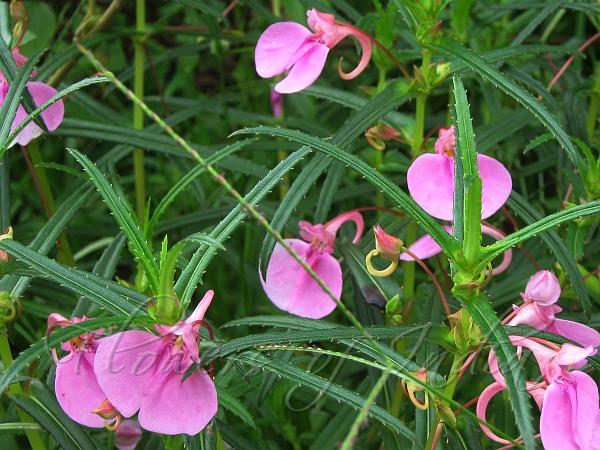|
| Chinese Balsam |
|

|

| File size | 1110657 |
| Original date | 8/5/09 12:45 PM |
| Resolution | 2400 x 1800 |
| Flash | Flash did not fire, auto |
| Focal length | 12.051mm |
| Exposure time | 1/100s |
| Aperture | 4.0 |
| Focus Distance | |
| Metering Mode | Multi-segment |
| Camera make | Canon |
| Camera model | Canon PowerShot A470 |
| Sensor type | OneChipColorArea |
|
|
|
|
Photo: |
Botanical name: Impatiens chinensis Family: Balsaminaceae (Balsam family)
Synonyms: Impatiens cosmia, Impatiens setacea
Synonyms: Impatiens cosmia, Impatiens setacea
Chinese Balsam is an annual herb, found in NE India, often beside ponds,
streamsides, field margins and swamps, at altitudes of 100-1200 m. Plant
grows up to 1-2 ft tall, with stem which erect in upper part, prostrate at
the base, slender, hairless. Nodes are slightly swollen, with adventitious
roots. Oppositely arranged leaves are stalkless or nearly so, narrow
linear or linear-lanceshaped. Leaves are gray-green below, green on the
upper side, 2-10 cm long, and only 0.5-1 cm wide, rigidly papery. Leaf
margin has widely separated spiny teeth. Flowers arise either singly or
2-3 fascicled in leaf axils. Slender flower stalks are 2-4.4 cm. Flowers
are large, purple-red or white. Lateral sepals are linear, 1 × 0.1 cm.
Lower sepal is funnel-shaped, 1.5 cm deep, gradually narrowed into an
incurved or involute, slender spur. Upper petal circular, 1 cm in
diameter; lateral united petals are not clawed, 1.4-1.5 cm, 2-lobed; basal
lobes nearly circular, small. Farther lobes are broadly obovate to
axe-shaped, apex rounded-obtuse; auricle narrow. Stamens are 5, with
linear filaments. Capsule is elliptic. Flowering: June-August.
Medicinal uses: The whole plant is used medicinally for
relieving fever and pain, removing toxic materials, promoting blood
circulation, treating diarrhea, curing urinary infections, and healing
carbuncles. In Manipur, the plant is used externally in burns, and taken
internally with milk in gonorrhea.
The whole plant is used medicinally for
relieving fever and pain, removing toxic materials, promoting blood
circulation, treating diarrhea, curing urinary infections, and healing
carbuncles. In Manipur, the plant is used externally in burns, and taken
internally with milk in gonorrhea.
Medicinal uses:
 The whole plant is used medicinally for
relieving fever and pain, removing toxic materials, promoting blood
circulation, treating diarrhea, curing urinary infections, and healing
carbuncles. In Manipur, the plant is used externally in burns, and taken
internally with milk in gonorrhea.
The whole plant is used medicinally for
relieving fever and pain, removing toxic materials, promoting blood
circulation, treating diarrhea, curing urinary infections, and healing
carbuncles. In Manipur, the plant is used externally in burns, and taken
internally with milk in gonorrhea. | Identification credit: Tabish | Photographed in Meghalaya & Assam. |
• Is this flower misidentified? If yes,